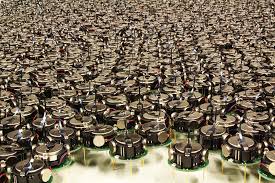Market Overview and Growth Trends
Recent years have seen significant expansion in the swarm robotics industry. Projections indicate that the market value will increase from $1.11 billion in 2024 to $1.46 billion in 2025, reflecting a compound annual growth rate (CAGR) of 31.6%. This growth has been fueled by advances in industrial automation, the rising demand for unmanned systems, increased investments in R&D, and enhanced applications in defense and security.
Looking further ahead, the market is expected to reach approximately $4.33 billion by 2029, growing at a CAGR of 31.3%. The forecasted expansion is driven by factors such as the growing role of 5G and edge computing, heightened demand for precision agriculture, integration with the Internet of Things (IoT), expansion of smart city initiatives, and increasing use in healthcare and emergency services. Emerging trends during this period include diversified applications, deeper integration with artificial intelligence and machine learning, bio-inspired algorithms, collaborative swarm operations, and enhanced connectivity.
Key Drivers of Market Expansion
The push toward smart manufacturing is a primary catalyst for the swarm robotics market’s growth. Smart manufacturing combines technologies like IoT, AI, and automation to improve production processes and supply chain operations, resulting in higher efficiency and productivity. The need for better operational efficiency, cost-effectiveness, and the ability to quickly adapt to market changes is driving the adoption of smart manufacturing practices. For instance, a December 2022 report by Conexus Indiana noted a 35% increase in the adoption of smart technologies compared to 2021, along with a 13% rise in companies allocating budgets for technology adoption and strategic planning. This growing trend in smart manufacturing is expected to further support the market expansion for swarm robotics.
Leading Companies in the Swarm Robotics Sector
Several major players are influencing the evolution of the swarm robotics market. These include:
- The Boeing Company
- Rolls-Royce Holdings PLC
- KION GROUP AG
- Idaho National Laboratory
- École Polytechnique Fédérale de Lausanne (EPFL)
- Technische Universiteit Delft
- Swisslog Holding AG
- Boston Dynamics Inc.
- Ars Electronica Futurelab GmbH
- Exyn Technologies Inc.
- Bristol Robotics Laboratory
- Scientific Systems Company Inc.
- DoBots B.V.
- Power-Blox AG
- Hydromea SA
- Unanimous A.I. Inc.
- Swarm Technology LLC
- SwarmFarm Robotics Pty Ltd
- Sentien Robotics LLC
- Berkeley Marine Robotics
- FARobot Inc.
- K-Team Corporation
- Robotics Inventions Inc.
- AGILOX Services GmbH
Innovative Trends Shaping the Industry
Industry leaders are leveraging advanced AI and machine learning techniques to develop sophisticated robotic systems, such as AI-driven mining robots that enhance efficiency, safety, and ore extraction rates. These systems use fleets of autonomous robots coordinated through AI and swarm strategies to perform mining tasks both underground and on the surface safely and efficiently. As an example, in January 2023, New Zealand-based Robotics Plus Ltd. unveiled a set of AI-powered swarm robots designed for precision agriculture, showcasing the potential to significantly boost production capabilities. These robots can operate continuously, learning from human experts to optimize performance, and in mining applications, they promise to replace traditional methods with electric, precision-driven approaches that reduce carbon emissions.
Market Segmentation
The swarm robotics market is segmented in several key areas:
- By Platform:
- Unmanned Ground Vehicles (UGVs)
- Unmanned Aerial Vehicles (UAVs)
- Other Platforms
- By Application:
- Security, Inspection, and Monitoring
- Mapping and Surveying
- Search and Rescue, and Disaster Relief
- Supply Chain and Warehouse Management
- Additional Applications
- By End User:
- Military and Defense
- Industrial
- Agriculture
- Healthcare
- Other Sectors
For UGVs, segments include autonomous mobile robots, agricultural robots, search and rescue robots, ground delivery robots, industrial inspection vehicles, and military ground robots. UAV segments cover delivery drones, aerial surveillance systems, agricultural drones for crop monitoring, environmental monitoring UAVs, military swarm drones, and autonomous mapping drones. Other platforms comprise underwater unmanned vehicles, marine exploration swarms, space exploration robots, hybrid systems combining multiple vehicle types, and healthcare robotics such as surgical robots.
Regional Dominance
In 2023, North America led the global swarm robotics market. Other regions analyzed in the market report include Asia-Pacific, Western Europe, Eastern Europe, South America, the Middle East, and Africa.
Report Highlights
The comprehensive market report on swarm robotics includes:
- Market Size Analysis: Evaluating the market size by region, country, product type, and application.
- Market Segmentation: Breaking down the market into subsegments for detailed categorization.
- Key Player Insights: Assessing major players’ market shares, value, and competitive landscapes.
- Growth Trends: Reviewing individual growth trends and future market prospects.
- Segment Contributions: Analyzing how various segments contribute to overall market growth.
- Growth Drivers: Outlining the key factors that are fueling market expansion.
- Industry Challenges: Identifying the risks and challenges that may affect the market.
- Competitive Developments: Highlighting developments such as expansions, strategic agreements, and new product launches.





